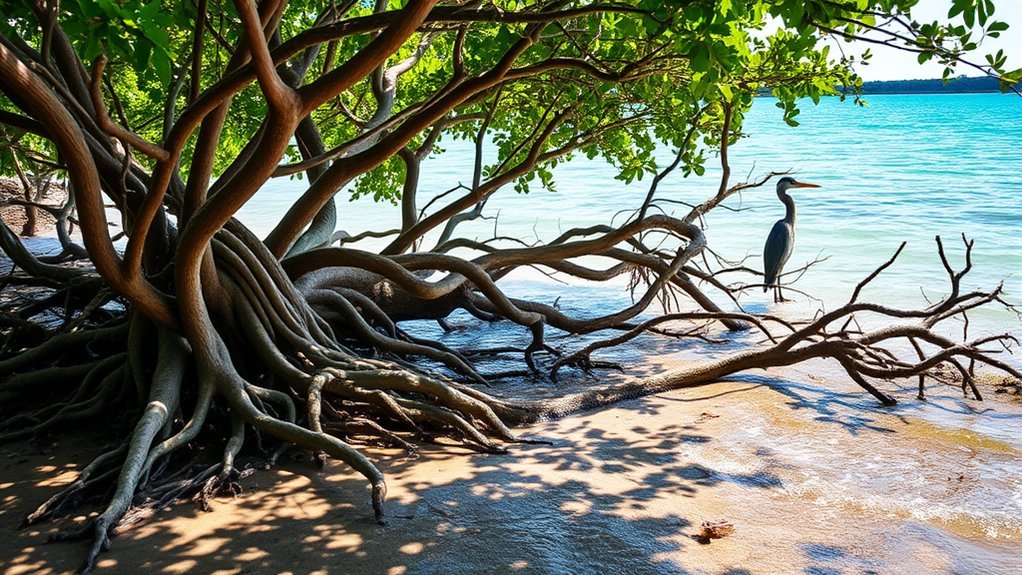Imagine you are on a beach, looking at mangrove trees standing strong against the waves. These amazing trees can grow in salty places where most trees can’t. Their roots dig deep into the mud, helping them stay steady during big storms. Mangroves are not just tough trees; they also mean a lot to the people living near the coast. They connect the community with nature in special ways. What if their importance is more than just being trees by the water?
Key Takeaways
Mangroves are special trees that grow along coastlines. They are strong and can survive in tough places, like salty water and strong storms. Their roots are unique because they help keep them stable in the ever-shifting sand. This stability is important because it provides homes for many kinds of fish and sea creatures.
For the people living near them, mangroves mean strength and endurance. Coastal communities depend on mangroves for food, shelter, and safety from storms. These trees play a big role in protecting shorelines by cleaning the water and stopping erosion. They show how land and sea are connected.
Many people are working together to save mangroves. These efforts focus on keeping the mangroves healthy and preserving their cultural importance. As more challenges arise for our environment, the value of mangroves continues to grow.
The Resilience of Mangroves
Mangroves aren’t just trees along coastlines; they tell a powerful story of survival.
These amazing trees grow in salty water and find ways to live through tough tides and storms. Their roots dig into the sand, keeping them steady and providing homes for many animals like fish and birds.
Mangroves also show us how healthy our coastlines are.
When you walk among their roots, you can feel how everything is connected. This reminds us that even in hard times, growth and strength can happen.
Watching mangroves stand strong inspires us. They truly represent resilience.
Adaptability in Harsh Environments
Mangroves grow in salty water and strong storms. They’re special trees that can live where many other plants cannot. Mangroves have unique roots that help them stay firmly planted in shifting mud and sand. They can filter salt through special glands, which helps them deal with the salty water and stay alive.
These trees can also handle flooding and strong winds. This shows how tough they’re and how important they’re to the coastal environment.
When you see mangroves, you can feel the power of how they adapt to tough situations. They remind us that life can still thrive even in places that seem hard to live in.
Mangroves help us connect to nature and show us that we can make it through challenges.
The Ecological Importance of Mangroves
Mangroves are important for our coastlines. They act like a natural wall that protects the land from strong waves and storms.
These beautiful mangrove forests provide homes for many animals. Birds, fish, and little sea creatures all find food and shelter in the mangroves.
Mangroves help keep our waters clean. They filter out harmful dirt and chemicals before they reach the ocean. This helps keep the sea life healthy.
They also stop soil from washing away, which helps keep our beaches safe.
When you visit a mangrove forest, you see a lively place where land and sea meet. You might spot colorful birds and jumping fish.
It’s a reminder of nature’s strength.
Let’s take care of these special places. Protecting mangroves helps keep our planet healthy and beautiful for everyone, now and in the future.
Cultural Significance of Mangroves
Mangroves are special trees found in coastal areas, and they mean a lot to the people living nearby. These trees grow in muddy water and are home to many animals. Coastal communities tell stories about mangroves that show how strong and connected they feel to their land.
In many cultures, mangroves stand for strength and endurance. They protect the people and provide food, which makes them very important. Locals celebrate these trees through art, traditions, and rituals, creating a sense of belonging among the community.
When you visit a mangrove area, remember that these trees are more than just plants. They’re a big part of the local culture. The stories told about them link families and friends together, lovingly honoring nature’s beauty and power.
Conservation Efforts and Future Challenges
Coastal communities are starting to understand how important mangroves are. These trees help protect shorelines and support many animals. Now, more locals are getting involved in projects to save and plant mangroves. They work together to plant young trees and take care of the ones that are already there.
These activities help people feel connected to their community and learn about why mangroves matter.
But some problems still exist. Climate change and city growth can harm these sensitive areas. By teaming up with conservation groups, you can help protect these vital coastal habitats for the future.
Getting involved in these efforts not only strengthens the community but also deepens everyone’s connection to nature. Together, we can make a positive impact!
Frequently Asked Questions
How Do Mangroves Contribute to Local Economies?
Mangroves help local economies in two main ways: through tourism and fishing. People love to visit mangroves to see the beautiful plants and animals. This type of tourism brings money to local communities and helps them appreciate nature.
Fishing in mangrove areas is also important. It provides fresh fish for families and supports fishermen. When locals fish in a sustainable way, they protect the mangroves and the sea life.
Both tourism and fishing build strong community bonds. They help people work together to care for their environment. This way, locals not only earn a living but also support the health of their natural surroundings.
What Animals Rely on Mangrove Ecosystems?
Mangrove habitats are special places where many animals live. Crabs, birds, and fish thrive in these areas. When we take care of coastal ecosystems, we help keep these animals safe. Protecting mangroves is important for a balanced environment. This balance supports both wildlife and communities that care about nature and sustainability. Let’s work together to protect these vital ecosystems!
Can Mangroves Be Planted in Non-Coastal Areas?
You can try to plant mangroves away from the coast, but it is not easy. Mangroves have special needs for salt and water levels. These needs make it hard for them to grow far from the coast. Still, with some creative ideas, you might see some success. It’s an interesting experiment!
How Do Mangroves Filter Water?
Mangroves filter water with their special root systems. These roots catch dirt and sand, which helps keep the water clean. This natural cleaning makes the water better for plants and animals. When you see mangroves, you can appreciate how they help the environment and create a lively place for many creatures to live.
What Symbolic Meanings Do Mangroves Hold in Different Cultures?
Mangroves are more than just trees; they are important to many cultures. They mean a lot to people because they show strength and how connected everything in nature is. Mangroves provide homes and food for many animals and plants. They also protect coastlines from storms, making them valuable to the communities that live nearby.
In some cultures, mangroves are seen as sacred spaces. People might hold ceremonies under their branches or tell stories about them. For many, mangroves are symbols of life and survival. They remind us that nature is a big web where everything matters. We rely on them for both our well-being and the health of the oceans.

Hello, I’m Zephyra, your guide at SpiritualityEssence.com. I’m passionate about uncovering life’s mysteries and sharing transformative insights. Let’s explore mindfulness, ancient rituals, and the path to a more awakened life together. Join me on this spiritual journey!

















